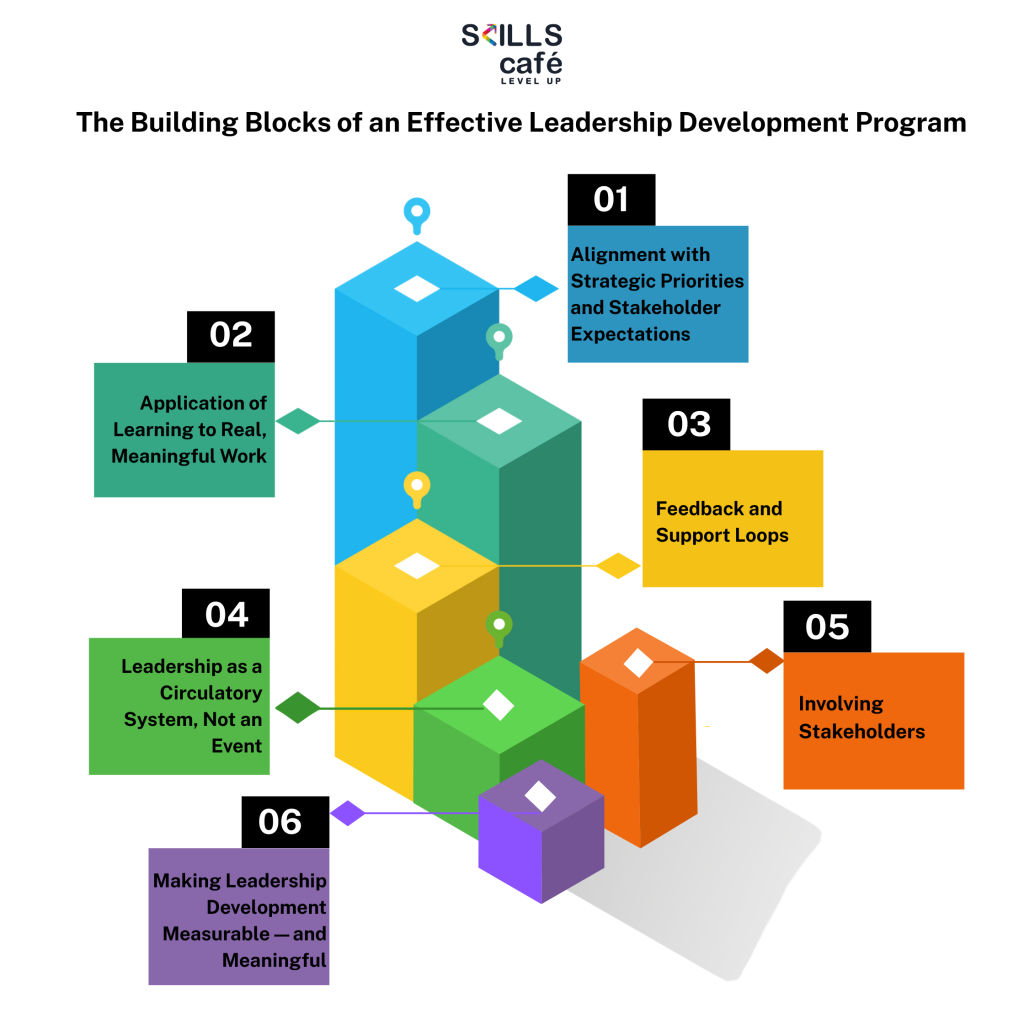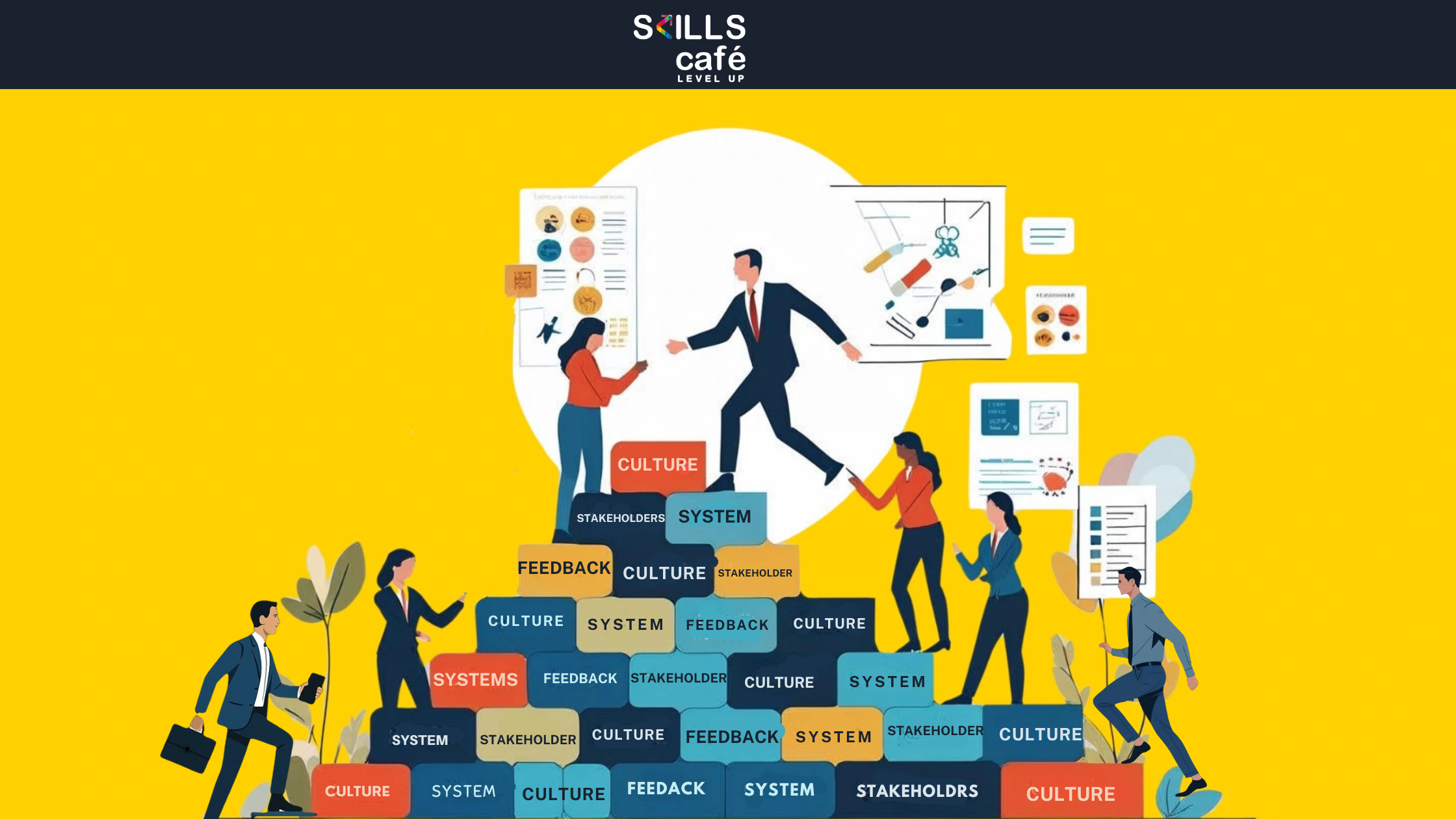Organizations today are investing heavily in leadership development programs—but many programs fail to deliver sustained impact. The reason? Leadership doesn’t operate in a vacuum. It exists within the fabric of organizational culture, hierarchy, and systems. Without shifting these systems alongside individual development, even the best programs risk becoming a checkbox activity.
Imagine pulling a fishnet out of water by grabbing just one knot. The section you’re holding rises, but the rest of the net hangs back — pulling your efforts down with it. Leadership development works the same way. Elevating a single individual without changing the environment around them creates tension and resistance. Effective programs must lift the whole net—aligning structures, stakeholders, and opportunities to enable leaders to succeed.
The Building Blocks of an Effective Leadership Development Program
The most effective leadership development programs are deeply embedded in the business reality of the organization and are built on six non-negotiables:
1. Alignment with Strategic Priorities and Stakeholder Expectations
Leadership programs must not be generic. They need to align with the unique challenges, opportunities, and power dynamics within the business. This includes involving direct managers, senior leaders, and even cross-functional stakeholders early on.
When sponsors and line managers visibly support the initiative—as seen in one North American firm where the CEO routinely dropped in on sessions—it signals that leadership development is not optional; it’s cultural. This kind of alignment sustains programs even through leadership transitions.
2. Application of Learning to Real, Meaningful Work
Content must translate into action. That means going beyond surface-level tasks. Leaders should be pushed to engage in real-world, strategic projects that challenge them to think systemically.
For instance, rather than asking a participant to conduct a routine feedback session, challenge them to identify predictors of performance in their unit and influence change. When learning is earned—through complexity, reflection, and ownership—it drives real behavior change.
These opportunities go beyond technical expertise and traditional soft skills training for employees. They challenge leaders to apply judgment, influence outcomes, and lead to systemic change.
3. Feedback and Support Loops That Sustain Growth
Leadership is not built in a day—or in a two-day workshop. Ongoing support through mentoring, coaching, peer feedback, and post-program check-ins helps leaders convert learned knowledge into earned knowledge. Programs may also include behavioral skills workshops that support the translation of learning into observable habits.
The best programs build this into their design. They ensure learners have the psychological safety and guidance to experiment, reflect, and evolve.
4. Leadership as a Circulatory System, Not an Event
Another hallmark of effective leadership development programs? They don’t treat development as an isolated event. Instead, they build an internal leadership circulatory system—one that continuously draws potential from deeper levels of the organization and channels it upward.
Think of it like a tree. Water rises from the roots, nourishing the entire system. In strong organizations, first-time leaders are nurtured, given space to grow, and move into roles of influence over time. The leadership engine isn’t episodic—it’s constant, dynamic, and self-renewing.
With systems in place, the next question is—what exactly are we developing in these leaders?
5. Involving Stakeholders for Implementing Leadership Development Programs Effectively
One of the strongest predictors of long-term impact in leadership development is the involvement of line managers. Yet, paradoxically, they are often left out of the process.
Leadership growth cannot happen in isolation. When participants return to teams where their development is unsupported—or worse, invisible—new mindsets and behaviors often erode. Successful programs recognize this and make manager capability building a non-negotiable element of the process.
A practical way to embed this is through a RACI model, where managers are clearly defined as:
- Responsible for enabling on-the-job application
- Accountable for follow-through on development goals
- Consulted during learning design or stretch project planning
- Informed about program milestones and progress
When managers are brought in early—through involvement in goal setting, mentoring conversations, and feedback loops—they don’t just support learning. They amplify and extend it. Their reinforcement helps participants apply new skills, navigate challenges, and grow in real time.
This also strengthens program measurement. Managers can offer valuable behavioral feedback, observe changes in team dynamics, and help identify emerging leadership potential. Their involvement turns individual growth into a shared, sustained journey that benefits the entire organization.
6. Making Leadership Development Measurable—and Meaningful
Tracking the right metrics ensures leadership development programs stay relevant, strategic, and impactful. It’s not just about how many people complete the program—it’s about how the experience translates into meaningful growth and contribution.
Key indicators include:
- Program completion rates
Completion rates are more than a logistical metric—they reflect how engaged participants are and how seriously the organization treats leadership development. High completion rates often indicate a well-designed, well-supported program. It’s a sign that participants and their managers see the initiative as valuable. This, in turn, helps secure ongoing buy-in from senior stakeholders and signals that leadership development is embedded—not optional.
- Internal mobility
Leadership programs should fuel progression. Tracking how many first-time managers or mid-level leaders move into broader, more strategic roles post-program provides valuable insight. It offers a direct view into the program’s impact on career trajectories This metric is especially valuable for succession planning and building internal leadership pipelines. It also helps HR and L&D teams spot patterns. They can identify who is growing, where they’re getting stuck, and what support might be needed at the next level.
- Engagement in critical projects post-program
Perhaps the most telling metric of all: are participants stepping into bigger challenges? Are they being trusted with key initiatives, cross-functional teams, or business-critical assignments? This indicates that the learning is not only understood but actively applied. It also demonstrates that the organization sees these individuals as capable of driving outcomes—not just learning about them.
For instance, one organization tracks how many participants from Level 1 of their leadership development program are nominated for Level 2 over a three-year span. This kind of long-view data reinforces a simple truth: leadership is not an event—it’s a journey. Measuring what matters ensures that journey is both supported and sustained.

Conclusion
Implementing leadership development programs effectively requires more than great content or charismatic facilitators. It means treating leadership development as a strategic lever—one that is aligned with real business priorities, supported by stakeholder involvement, reinforced on the job, and measured in ways that matter.
Organizations that invest in this kind of systemic approach don’t just develop individual leaders—they create the conditions for leadership to thrive across the enterprise. When programs are thoughtfully designed and executed, leadership becomes not just a role, but a capability embedded in the way the organization works, grows, and adapts.

